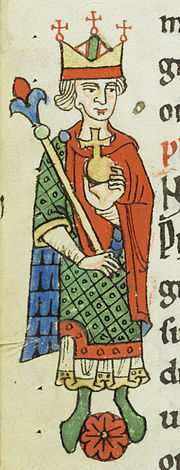| Philip | |
|---|---|
 Philip of Swabia with the Imperial Regalia, miniature in the Chronicle of Weissenau Abbey, ca. 1250. Kantonsbibliothek St. Gallen (Vadiana Collection, Ms. 321, p. 40.) | |
| King of Germany (King of the Romans) | |
| Reign | 8 March 1198 – 21 June 1208 |
| Coronation | 8 September 1198, Mainz |
| Predecessor | Henry VI |
| Successor | Otto IV |
| Duke of Swabia | |
| Reign | 15 August 1196 – 21 June 1208 |
| Predecessor | Conrad II |
| Successor | Frederick IV |
| Born | February/March 1177 Pavia, Italy |
| Died | 21 June 1208 (aged 31) Bamberg, Franconia, Germany |
| Burial | |
| Spouse | |
| Issue | |
| House | Hohenstaufen |
| Father | Frederick I, Holy Roman Emperor |
| Mother | Beatrice I, Countess of Burgundy |
Philip of Swabia (February/March 1177 – 21 June 1208), styled Philip II[a] in his charters, was a member of the House of Hohenstaufen and King of Germany from 1198 until his assassination.
The death of Philip's older brother Henry VI, Holy Roman Emperor, in 1197 meant that the Hohenstaufen rule (which reached as far as the Kingdom of Sicily) collapsed in imperial Italy and created a power vacuum to the north of the Alps. Reservations about the kingship of Henry's underage son, Frederick, led to two royal elections in 1198, which resulted in the German throne dispute: the two elected kings, Philip of Swabia and Otto of Brunswick, claimed the throne for themselves. Both opponents tried in the following years through European and papal support, with the help of money and gifts, through demonstrative public appearances and rituals, to decide the conflict for oneself by raising ranks or by military and diplomatic measures. Philip was able to increasingly assert his kingship against Otto in the north part of the Alps. However, at the height of his power, he was assassinated in 1208. This ended the dispute for the throne; his opponent Otto quickly found recognition. Philip was the first German king to be murdered during his reign. In posterity, Philip is one of the little-noticed Hohenstaufen rulers.
- ^ Maiorov 2021, p. 260.
Cite error: There are <ref group=lower-alpha> tags or {{efn}} templates on this page, but the references will not show without a {{reflist|group=lower-alpha}} template or {{notelist}} template (see the help page).